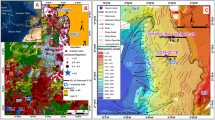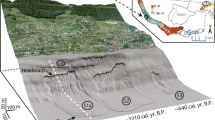Abstract
Submarine landslides occur frequently on most continental margins. They are effective mechanisms of sediment transfer but also a geological hazard to seafloor installations. In this paper, submarine slope stability is evaluated using a 2D limit equilibrium method. Considerations of slope, sediment, and triggering force on the factor of safety (FOS) were calculated in drained and undrained (Φ=0) cases. Results show that submarine slopes are stable when the slope is <16° under static conditions and without a weak interlayer. With a weak interlayer, slopes are stable at <18° in the drained case and at <9° in the undrained case. Earthquake loading can drastically reduce the shear strength of sediment with increased pore water pressure. The slope became unstable at >13° with earthquake peak ground acceleration (PGA) of 0.5 g; whereas with a weak layer, a PGA of 0.2 g could trigger instability at slopes >10°, and >3° for PGA of 0.5 g. The northern slope of the South China Sea is geomorphologically stable under static conditions. However, because of the possibility of high PGA at the eastern margin of the South China Sea, submarine slides are likely on the Taiwan Bank slope and eastern part of the Dongsha slope. Therefore, submarine slides recognized in seismic profiles on the Taiwan Bank slope would be triggered by an earthquake, the most important factor for triggering submarine slides on the northern slope of the South China Sea. Considering the distribution of PGA, we consider the northern slope of the South China Sea to be stable, excluding the Taiwan Bank slope, which is tectonically active.
Similar content being viewed by others
References
Albataineh N. 2006. Slope staility analysis using 2D and 3D methods. M.S. Thesis. University of Akron. p.1–36.
Amante C, Eakins B W. 2009. ETOPO1 1 Arc-Minute Global Relief Model: Procedures, Data Sources and Analysis. NOAA Technical Memorandum NESDIS NGDC-24. p.1–19.
Apuani T, Corazzato C, Cancelli A et al. 2005. Stability of a collapsing volcano (Stromboli, Italy): limit equilibrium analysis and numerical modelling. J. Volcanol. Geoth. RES, 144: 191–200.
Azizian A, Popescu R. 2006. Three-dimensional seismic analysis of submarine slope. Soil Dyn. Earthqu. Eng., 26: 870–887.
Biscontin G, Pestana J M, Nadim F. 2004. Seismic triggering of submarine slides in soft cohesive soil deposits. Mar. Geol., 203: 341–354.
Bühring C, Sarnthein M, Erlenkeuser H. 2004. Toward a highresolution stable isotope stratigraphy of the last 1.1 m.y.: Site 1144, South China Sea. In: Prell W L, Wang P, Blum P, Rea D K, Clemens S C eds. Proc. ODP, Sci. Results, 184: 1–29.
Cai G Q, Peng X C, Chen H J et al. 2012. The component characteristics and paleoenvironmental significances for sediments in core 83PC from the Xisha Trough, South China Sea. Marine Geology and Quaternary Geology, 32(1): 77–84. (in Chinese with English abstract)
Chapron E, Beck C, Pourchet M et al. 1999. 1822 earthquaketriggered homogenite in Lake Le Bourget (NW Alps). Terra, 11: 86–92.
Chen R F, Kang Y, Huang X H, Yang X, Ding Y Z. 2009. Seismic risk analysis in northern South China Sea. South China Journal of Seismology, 29(4): 36–45. (in Chinese)
Chen J R, Yang M Z. 1996. Research on the potential factors for geologic hazards in South China Sea. Journal of Engineering Geology, 4(3): 34–39. (in Chinese with English abstract)
Chiu J K, Tseng W H, Liu C S. 2006. Distribution of gassy sediments and mud volcanoes offshore southwestern Taiwan. Terr. Atmos. Ocean. Sci., 17(4): 703–722.
Dimitrov L I. 2002. Mud volcanoes- the most important pathway for degassing deeply buried sediments. Earth-Sci. Rev., 59: 49–76.
Ding W W, Li J B, Han X Q et al. 2010. Geomorphology, grain-size charicteristics, matter source and forming mechanism of sediment waves on the ocean bottom of the northeast South China Sea. Acta Oceanol. Sin., 32(2): 96–105. (in Chinese)
Feng W K, Shi Y H, Chen L H. 1994. Research for seafloor landslide stability on the outer continental shelf and the upper continental slope in the northern South China Sea. Marine Geology and Quaternary Geology, 14(2): 81–94. (in Chinese with English abstract)
Grozic J L H, Nadim F, Kvalstad T J. 2005. On the undrained shear strength of gassy clays. Computers and Geotechnics, 32: 483–490.
Hance J J. 2003. Development of a database and assessment of seafloor slope stability based on published literature. M.S. Thesis. The University of Texas, Austin. p.245.
Hayes D E, Nissen S S. 2005. The South China Sea margins: implications for rifting contrasts. Earth and Planetary Science Letters, 237: 601–616.
He J X, Zhu Y H, Weng J N et al. 2010. Characters of northwest mud diapirs volcanoes in South China Sea and relationship between them and accumulation and migration of oil and gas. Earth Science—Journal of China University of Geoscien ces, 35(1): 75–86. (in Chinese with English abstract)
Heureux J L, Hansen L, Longva O et al. 2009. A multidisciplinary study of submarine landslides at the Nidelva fjord delta, Central Norway — implications for geohazard assessment. Norwegian Journal of Geology, 99: 1–20.
Huang J, Li A C, Wan S M. 2011. Sensitive grain-size records of Holocene East Asian summer monsoon in sediments of northern South China Sea slope. Quaternary Res., 75: 734–744.
Huvenne V A I. 2002. 3D view of an ancient sediment collapse and slope failure. Terra Nova, 14(1): 33–40.
Hynes-Griffin M E, Franklin A G. 1984. Rationalizing the Seismic Coefficient Method. Miscellaneous Paper GL-84-13, US Army Corps of Engineers. p.40.
Kvalstad T J, Andresen L, Forsberg C et al. 2005. The Storegga slide: evaluation of triggering sources and slide mechanics. Marine and Petroleum Geology, 22(1–2): 245–256.
Kvalstad T J, Nadim F, Kaynia A M et al. 2005. Soil condition and slope stability in the Ormen Lange area. Marine and Petroleum Geology, 22: 299–310.
Lee H J, Edwards B D. 1986. Regional method to assess offshore slope stability. J. Geotech. Geoenviron. Eng., 112: 486–509.
Leynaud D, Mienert J, Nadim F. 2004. Slope stability assessment of the Helland Hansen area offshore the mid-Norwegian margin. Mar. Geol., 213: 457–480.
Leynaud D, Sultan N, Mienert J. 2007. The role of sedimentation rate and permeability in the slope stability of the formerly glaciated Norwegian continental margin: the Storegga slide model. Landslides, 4(4): 297–309.
Li S J, Chu F Y, Fang Y X, Wu Z Y, Ni Y G. 2010. Associated interpretation of sub-bottom and single-channel seismic profiles from slope of Shenhu Area in the northern South China Sea—characteristics of gas hydrate sediment. Journal of Tropical Oceanography, 29(4): 56–62. (in Chinese)
Locat J, Lee H. 2002. Submarine landslides: advances and challenges. Canadian Geotechnical Journal, 39(1): 193–212.
Luan X W, Zhang L. 2009. Tectonic evolution models of South China Sea: passive spreading under complex actions. Marine Geology and Quaternary Geology, 29(6): 59–74. (in Chinese)
Masson D G, Harbitz C B, Wynn R B et al. 2006. Submarine landslides: process, triggers and hazard prediction. Phil. Trans. R. Soc. A, 364: 2 009–2 039.
Matthew J H, Steven A M, Nancy R G et al. 2008. Did a submarine slide trigger the 1918 Puerto Rico tsunami? Science of Tsunami Hazards, 27(2): 22–31.
McAdoo B G, Pratson L F, Orange D L. 2000. Submarine landslide geomorphology, US continent slope. Mar. Geol., 169: 103–136.
Mienert J, Berndt C, Laberg J S, Vorren T O. 2002. Submarine landslides on continental margins. In: Wefer G et al eds. Ocean Margins Systems. Springer Verlag. p.179–193.
Mienert J. 2004. COSTA-continental slope stability: major aims and topics. Mar. Geol., 213: 1–7.
Nittrouer C A. 1999. STRATAFORM: overview of its design and synthesis of its results. Mar. Geol., 154: 3–12.
Sarnthein M, Pflaumann U, Wang P X, Wong H K. 1994. Preliminary report on Sonne-95 Cruise “Monitor Monsoon” to the South China Sea. Rep. Geol. Palaontol. Inst. Univ. Kiel. p.68.
Scholz N A, Spence G D, Hyndman R D et al. 2011. Do dissociating gas hydrated play a role in triggering submarine slope failures? A case study from the northern Cascadia margin. Proceedings of the 7 th International Conference on Gas Hydrates. Edinburgh, Scotland, United Kingdom.
Seed H B, Tokimatsu K, Harder L F et al. 1985. The influence of SPT Procedures in soil Liquefaction Resistance evaluations. Journal of Geotechnical Engineering, ASCE, 111(12): 1 425–1 445.
Shao L, Li X H, Wei G J et al. 2001. Provenance of a prominent sediment drift on the northern South China Sea. Science in China (Series D), 31(10): 828–833. (in Chinese)
Strasser M, Stegmann S et al. 2006. Quantifying subaqueous slope stability during seismic shaking: lake Lucerne as model for ocean margins. Mar. Geol., 240: 77–97.
Sultan N, Cochonat P, Canals M et al. 2004. Triggering mechanisms of slope instability processes and sediments failures on continental margins: a geotechnical approach. Mar. Geol., 213: 291–321.
Sultan N, Cochonat P, Foucher J P et al. 2004. Effect of gas hydrates melting on seafloor slope instability. Mar. Geol., 213(1–4): 379–401.
Sultan N, Voisset M, Marsset B et al. 2007. Potential role of compressional structures in generating submarine slope failures in the Niger Delta. Mar. Geol., 237(3–4): 169–190.
Theodore W J, van Asch, Jean-Philippe M, Ludovicus P H, van Beek et al. 2007. Techniques, issue and advances in numerical modeling of landslide hazard. Bull. Soc., 178(2): 65–88.
Urgeles R, Leynaud D, Lastras G et al. 2006. Back-analysis and failure mechanisms of a large submarine slide on the Ebro slope, NW Mediterranean. Mar. Geol., 226: 185–206.
Wang P X, Prell W L, Blum P et al. 2000. Proceedings of the Ocean Drilling Program, Initial Reports South China Sea, V 184, College Station T X (Ocean Drilling Program).
Wang P X, Wang L J, Bian Y H et al. 1995. Late quaternary paleoceanography of the South China Sea: surface circulation and carbonate cycles. Mar. Geol., 127: 145–165.
Wang H R, Wang Y M, Qiu Y et al. 2008. Geomorphology and its control of deep-water slope of the margin of South China Sea. Atca Oceanologica Sinica, 30(2): 70–79. (in Chinese)
Wen K L, Beresnev I A, Cheng S N. 1996. Moderate-Magnitude seismicity remotely triggered in the Taiwan region by large earthquakes around the Philippine Sea Plate. Bulletin of the Seismological Society of America, 86(3): 843–847.
Wu S G, Qin Z L, Wang D W et al. 2011. Seismic characteristics and triggering mechanism analysis of mass transport deposits on the northern continental slope of the South China Sea. Chinese J. Geophys. 54(12): 3 184–3 195. (in Chinese)
Xie W Y, Zhang Y W, Sun Z et al. 2008. The mechanism research of the formation of the Qiongdongnan basin during the Cenozoic through modeling experiments. Earth Science Frontiers, 15(2): 232–241. (in Chinese)
Yao B C. 2001. The gas hydrate in the South China Sea. J. Trop. Ocea., 20(2): 20–28. (in Chinese)
Zheng Z C, Chen J R, Zhu Z Y. 2004. Physical and mechanical characteristics of seabed soils and its geological environment in South China Sea. Hydrogeology & Engineering Geology, 4: 50–65. (in Chinese)
Author information
Authors and Affiliations
Corresponding author
Additional information
Supported by the National Basic Research Program of China (973 Program) (No. 2007CB411702)
Rights and permissions
About this article
Cite this article
Zhang, L., Luan, X. Stability of submarine slopes in the northern South China Sea: a numerical approach. Chin. J. Ocean. Limnol. 31, 146–158 (2013). https://doi.org/10.1007/s00343-013-2060-z
Received:
Accepted:
Published:
Issue Date:
DOI: https://doi.org/10.1007/s00343-013-2060-z




